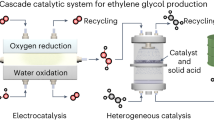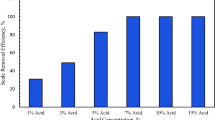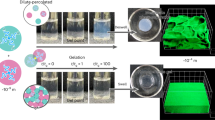Abstract
GILLE1 has described the formation of a thick gel by saturating ethylene glycol with gypsum, CaSO4.2H2O, at 19° C., filtering carefully, and heating the solution to 40° C., at which temperature, owing to its decreased solubility, the calcium sulphate precipitates, but in the form of a gel. Gypsum has a structure2 in which layers of water molecules alternate with CaSO4 layers, and Gille suggests that the last-mentioned layers are preserved in the gel, but with ethylene glycol substituted for the water, and causing an indefinite expansion.
This is a preview of subscription content, access via your institution
Access options
Subscribe to this journal
Receive 51 print issues and online access
$199.00 per year
only $3.90 per issue
Buy this article
- Purchase on SpringerLink
- Instant access to full article PDF
Prices may be subject to local taxes which are calculated during checkout
Similar content being viewed by others
References
Gille, F., Koll.-Z., 126, 154 (1952).
Wooster, W. A., Z. Krist., A, 94, 375 (1936).
MacEwan, D. M. C., Bull. 169, Calif. Div. of Mines, p. 78.
“X-Ray Diffraction by Polycrystalline Materials”, Chap. 5, p. 145 (Inst. Phys., London, 1955).
Beevers, C. A., and Raistrick, B., Nature, 173, 542 (1954).
Author information
Authors and Affiliations
Rights and permissions
About this article
Cite this article
RUÍ;Z, J., MACEWAN, D. Nature of Calcium Sulphate Gels in Ethylene Glycol. Nature 176, 1169 (1955). https://doi.org/10.1038/1761169a0
Issue date:
DOI: https://doi.org/10.1038/1761169a0



